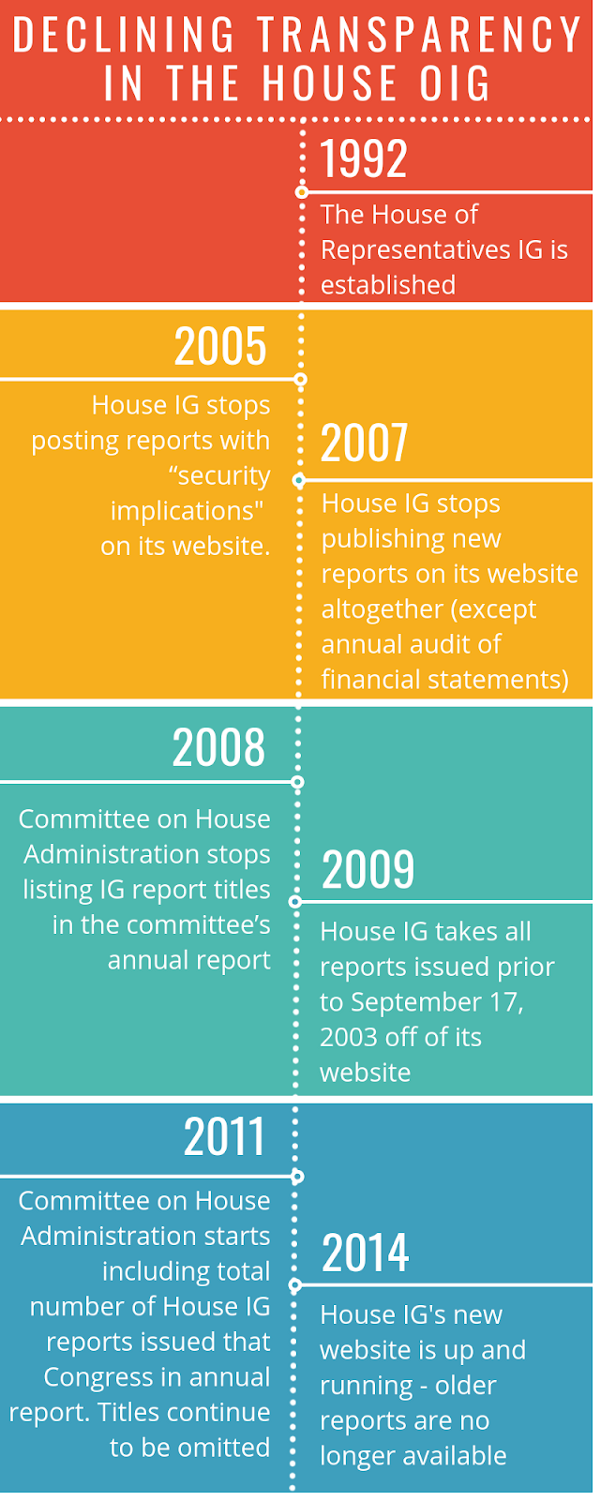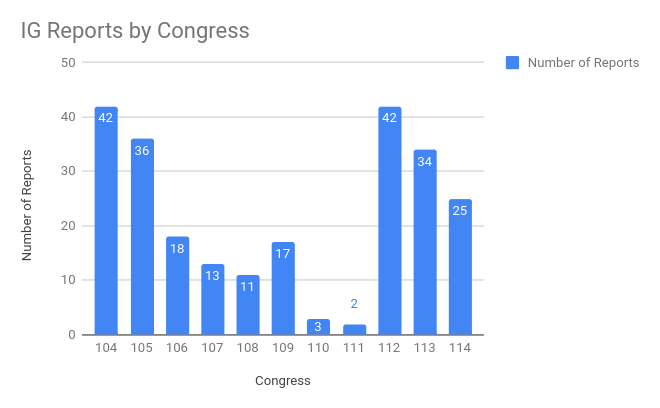The House of Representatives has an Inspector General that is authorized to provide independent, nonpartisan investigations into the House’s operations, but over the years that office’s findings have become largely shrouded from public view. In what ways has it become less transparent? How many reports does the office issue and what do they cover?
We looked at all the public records we could find since the IG’s office was created in 1992.
Our findings:
- Initially, many of the House Inspector General’s reports were made publicly available on its website, but now there is very little public information concerning the office’s work.
- While most federal Inspectors General have increased transparency concerning their findings, transparency concerning the House IG has decreased.
- Information about the work of the House Inspector General has been inconsistently made available to the public; we created our own inventory of House IG reports pieced together from publicly available information.
Information about the work of the House Inspector General has become increasingly opaque
The history of public availability of House Inspector General reports is one of increasing obscurity about its work.

Initially, the House IG posted many of its reports online, publishing 119 reports on its original website between the 104th-109th congresses (May 1995 to December 2006). Starting in 2005, however, the office indicated it would no longer include reports with “security” implications on the website, reducing the number of new reports it would publish online.
In 2007, the House IG stopped publishing new reports on its website altogether, with the exception of the annual audit of financial statements. Between March and May 2009, the House IG took down all reports from its website dated earlier than September 17, 2003, removing 109 reports and leaving only 14 reports online.
The House IG launched a new website in January 2014 — at some point discontinuing the old one — but it did not include any of the older reports except for the annual House financial audit reports from 2008 forward. The current website has the financial audit reports from 2013 forward.
Similarly, in the 108th and 109th congresses, the Committee on House Administration published the names of IG reports in its Activities Reports. In the 112th congress (2011–2012), the Committee began including the total number of reports issued by the House IG in its activity report, but did not include the titles of the reports.
The House Inspector General Appears Out of Step with IG Best Practices
The House IG should publish reports on its website within three days. Under the the Inspector General Empowerment Act of 2016, covered IGs are required to publish on the internet reports that contains recommendations for corrective action within three days of sending it to the agency. While the Act does not apply to the House IG, which is established under House Rule II(6), we believe the House IG should follow this best practice. As we mentioned above, the only documents available on the House IG’s website are recent annual financial audits. Older reports, which used to be published online, no longer are available. Unlike executive branch IG reports, which can be requested under FOIA, there is no comparable request mechanism for House IG reports. This is even more reason for the House IG to make an effort to make the documents available.
Even when the House IG cannot publish the report in full, it should still release at least some information about the report. Our colleagues at the Project on Government Oversight recently issued a report on IG best practices, drawn from a study of dozens of IGs, which included a recommendation that “Each IG should, at a minimum, publicize basic information (title of report, subject, date, and report number) for reports not made fully available to the public.” We believe the House IG should follow this best practice.
For example, the Justice Department IG lists its reports online, and will indicate whether they’ve released a summary and/or the full text. The Department of Defense lists all its reports in its monthly newsletter, including ones anticipated to be released in the next month that are classified. And the Government Accountability Office has a web page listing all of its “restricted” reports. While the contents of these reports are not publicly released, their existence is acknowledged.
The House IG should explore contributing reports to the IG website Oversight.gov, managed by the Council of the Inspectors General on Integrity and Efficiency (CIGIE), an independent entity composed of more than 70 inspectors general across the federal government. The vast majority of IGs publish their reports here, including four of the legislative branch IGs. The Architect of the Capitol has published 29 reports; the Government Accountability Office has published 24 reports; the Government Publishing Office has published 32 reports; and the Library of Congress has published 16 reports. (Oddly, while the Capitol Police is a member of CIGIE, it is not publishing any reports on that website.) All of the legislative branch IGs are identified as members of CIGIE except for the House IG; it may take legislation or direction from their oversight committee for them to officially participate in CIGIE.
What does the House Inspector General Investigate?
We were able to identify that the House Inspector General has issued over 240 reports between the 104th and 114th congresses; that count includes reports with clearly identifiable titles for the 104–111th congresses (142 reports) and relies on the House Activity Report for the total number of reports issued during the 112th-114th congresses. We created a list of all the report titles we could find and linked to a copy of the report whenever we had it. The inventory is here.
To accomplish this, we used the Internet Archive and the Committee on House Administration’s activity reports to identify report titles from the 104th to 114th Congresses (1995–2016). Because of the House’s publication practices, our list likely does not paint the whole picture.
The following chart shows the number of reports we identified each congress. We do not believe that the numbers we are showing are complete, especially for the 106th to 111th congresses. However, this is the best information that is available to us.

The bulk of reports concerned the following topics: a review of computer, data, and internet systems (40 reports); annual financial audits and related analysis (25 reports); and payment related issues including the financial management system, contracting flaws, and vendor fraud (14 reports).
The remaining reports concerned legislative branch offices like the Chief Administrative Officer, Architect of the Capitol, Clerk, and Sergeant at Arms as well as the operations of legislative branch facilities, such as the beauty shop, gift shop, office supply store, parking garages, recording studio, and more.
This partial list of topics shows the importance of the work of the House IG and how many of the issues they cover are of interest to members of Congress and the public. In addition, the House IG’s oversight work has strong parallels with the work of executive branch IGs, who conduct investigations on similar topics, and of course many of their reports are online.
The House IG should go back to its roots on public accountability
According to CRS, the Office of the House IG was created in 1992 in response to the House Post Office and banking scandals for the purpose of shedding sunlight on corruption. The increasing secrecy of an office originally intended to provide accountability may be counterproductive to that purpose.
There is reason to believe that the House IG is now viewed more as an investigatory arm of the Committee on House Administration, and thus its mission may be perceived to have changed. Some may argue that keeping the work of the IG secret makes it more likely that delicate political matters can be investigated and addressed. Doing so avoids the political complications of other members of the House looking at the reports and raising difficult political questions or stirring political controversy.
On the other hand, secrecy often breeds a lack of accountability. We saw this in a scandal with a different congressional office concerning harassment in the House and the refusal to release information about settlements, which made it possible for misbehavior to drag on. While this scandal should not be laid at the feet of the House IG, it is one of many examples of the dangers of secrecy.
We contacted the House IG’s office for comment, but they explained their practice is to refer all inquiries to the Committee on House Administration. We reached out to the Committee on House Administration, but they explained they do not comment on the work of the IG or the office generally.
The House IG is jointly appointed by the House Speaker, Majority Leader, and Minority leader. It is established under the rules of the House, which may change in the upcoming congress. Over the years, the rules governing the House IG have changed several times. Michael Ptasienski was appointed to that role in February 2018, and joined the House IG office in 2008.
Download the report as a PDF here. Download the inventory as a CSV here.
— Written by Amelia Strauss and Daniel Schuman
